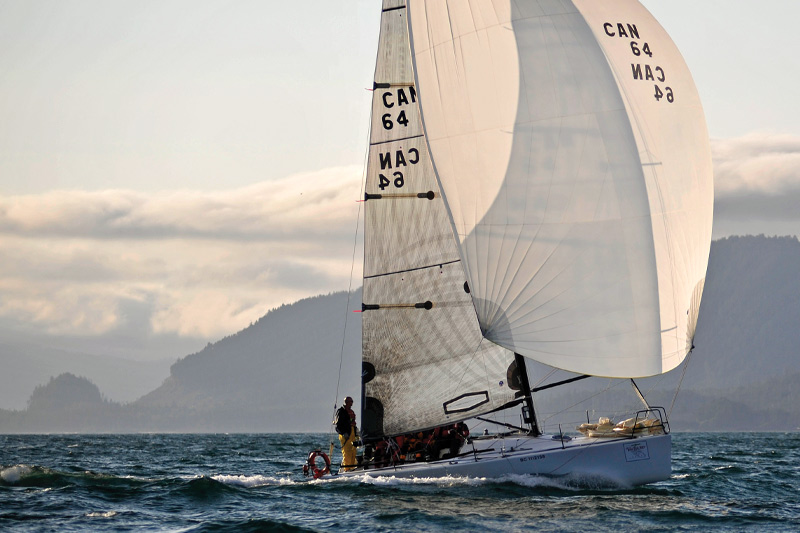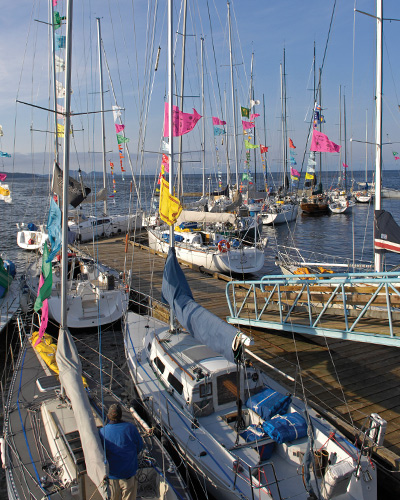
 As the starting clock ticks down the final seconds before the fourth leg of the 2017 Van Isle 360 begins, the fleet of 30 racing yachts push one another, ducking and weaving. This scene looks like the beginning of a Rolex championship regatta or offshore classic, except that the only spectators are bears roaming the beach and eagles soaring above. As the clock hits zero, the fleet comes onto the wind and a loud bang is heard across the water. Onboard the 1D48 Flash, our rig goes slack as we realize the forestay is no longer attached to the mast. The sails come down, halyards go forward for safety, and we head for the nearest marina — the three-dock, four-building town of Browns Point just north of Seymour Narrows.
As the starting clock ticks down the final seconds before the fourth leg of the 2017 Van Isle 360 begins, the fleet of 30 racing yachts push one another, ducking and weaving. This scene looks like the beginning of a Rolex championship regatta or offshore classic, except that the only spectators are bears roaming the beach and eagles soaring above. As the clock hits zero, the fleet comes onto the wind and a loud bang is heard across the water. Onboard the 1D48 Flash, our rig goes slack as we realize the forestay is no longer attached to the mast. The sails come down, halyards go forward for safety, and we head for the nearest marina — the three-dock, four-building town of Browns Point just north of Seymour Narrows.
Most would assume that the adventure is over, but in this race solving problems is part of the strategy. Using nothing more than a sharp file and a hammer, the forestay is fitted back into the mast. We arrive at the next stop as the sun sets to the applause of our competition and continue around Vancouver Island. And this was only day four of the two-week race.
The Van Isle 360 stands out from any race I’ve ever taken part. Stopping everywhere from the bustling tourist city of Victoria to the remote village of Winter Harbour, with its year-round population of ten, this race covers the complete spectrum of what sailing in the Pacific Northwest offers. Especially challenging is that the only spare parts allowed are what you bring aboard or deliver via chartered airplane. The old saying, “If it was easy, then everyone would do it” rings true as the marathon leg race not only requires a crew of seasoned sailors, but also resourceful boat builders and clever mechanics to keep the fleet moving for 14 days straight.

Race director and owner of Blast Performance Sailing, Jeff Motley, sums it up perfectly, “What makes Van Isle unique is the fact that it is 580 nautical miles but there are a few stops along the way. It’s not like Transpac or Vic Maui, where you lose track of your competition for two weeks. Every night everyone gets back together again to trade stories and ask about each other’s adventures.” Asking someone why they would want to sail a boat around Vancouver Island, let alone race it, results in a wide range of answers. Some are there for the competition, while others are looking for a challenge, but everyone comes ready for an adventure.
The race was the brain child of Wayne Gorey and Tim Knight, who in 1999 proposed a race around Vancouver Island, partly for the competition, but mostly to see if it could be done. No one knew if a scheduled multi-stage event was even possible, with the shifting winds, currents through the Inside Passage, and the potentially deadly offshore conditions on the island’s outside edge, not to mention the logistical challenge of a new town every night. Understandably, before 1990 such a race had never been attempted. The first race was held and nicknamed the “Ambassador Race” and was made possible by generous sponsorship from local British Columbia businesses. Hence this traveling circus of a yacht race was created and became an instant success. The following two races were held back-to-back in 2000 and 2001. But after three years on the trot, many involved wondered if perhaps a biannual format was more appropriate going forward.
Blast Performance Sailing stepped in to run the now biannual race in 2003. The initial changes saw a shift away from the large corporate sponsors and a migration towards a participant-supported event. This transition made it possible for the race to be self-supporting and consequently enabled race organizers and participants to plan without fear of needing sponsorships to take on this race’s challenges. Jeff Motley recognizes the commitment required from skippers and crew members to participate. “Especially the young guys. They are giving up all of their vacation to come do this, and you want to make sure when they come that the event itself is fun,” says Motley.

Now nearly 20 years old, Van Isle, as it has become known, has remained the pinnacle for many Northwest sailors’ bucket lists. At its core, the race takes part over two weeks every odd year, leaving from Nanaimo and sailing counterclockwise around Vancouver Island. Perhaps the most alluring part of this race is the opportunity to stop at all the communities around the island that even the most seasoned cruiser would not discover. The stops have shifted around over the years based on interest of the communities as well as for the benefit of the racing. This year’s 2017 race took place over nine legs with the shortest being just over 24 nautical miles through Discovery Passage, and the longest haul, a grueling 140 offshore miles.
The start and end of the race takes place in the city of Nanaimo. Nestled in a bay directly west of the city of Vancouver, Nanaimo is a prime location to begin any northern yachting trip. It’s convenient with daily direct flights from Seattle and Vancouver in addition to Tsawwassen ferry access. From here, boats undergo safety inspections and skippers meet to get everyone accounted for and ready to start racing. After the starting gun, the fleet heads south around the harbor entrance and then north into the Strait of Georgia. They pass Texada Island and face the tough decision on whether to go inside or outside Ballenas as they work towards Comox.
Traditionally the second stop along the route, Comox has now taken center stage as the destination of the first leg. Being the first stop, not many yet long for the comforts of home, but with great local restaurants and watering holes, it is a fine place to set the stage for the weeks to come. The next morning the departing fleet crosses the sometimes-treacherous sandbar that protects the marina and continues north towards Campbell River.
Located at the entrance to Queen Charlotte Strait, the traditional fishing village has grown into a full-on destination for anyone traveling north. The town’s success is in no small part to Seymour Narrows, located a few miles north of the marina and home to some of the most aggressive currents in the world, over 16 knots at some points. Everything from small pleasure boats to commercial vessels wait for the currents to change to make their way through the passage. The tough decision for the fleet is either heading through the Narrows from Browns Bay or waking up before the sun to make their way through the Narrows during the tide change.
With the race on schedule for 2019, the regular faces are already beginning to plan crew lists and request time off from work. More information regarding the next race can be found at vanisle360.com.

The race to Hardwicke Island feels more like sailing the Columbia Gorge than the Northwest Passage. With the shoreline little more than half-mile wide at parts, and ripping currents pushing along at five knots, this leg will always have a special place in my memory as one of the best days of upwind sailing I’ve experienced.
Perhaps the most unconventional stop on the course is Hardwicke Island, for this stop puts sailors on an overnight campout, rafted off an anchored fish farm. A full BBQ is hosted on the farm, and there are plenty of knowledgeable staff on site to answer questions and teach sailors about the science of fish farming. This is always a great opportunity for crews to spend time hanging around the boats without running off to dinner or to check into hotels. This most recent race saw several collisions on the leg to the fish farm, so it was a mad scramble as crews tried to make repairs using only what was available to them on board. In most cases, they had nothing! The next day’s race continues through the narrow channels of Queen Charlotte Straits and into the gorgeous storm hole of Telegraph Cove.
Telegraph Cove feels familiar to anyone who has sailed to Roche Harbor in the San Juan Islands, for it parallels the same small town feel. Quaint cottages line the shore and the one bar in town is constantly bustling with sailors during the stopover. The difference lies in the ever-present wildlife such as the endless warnings of bears ransacking garbage cans, and the orca pods that can be seen passing by. The whale museum is not to be missed, and the small coffee stand at the head of the dock has some of the best breakfast burritos I have found north of Victoria. After a full 24-hour lay day, the fleet heads out on a short jaunt through the islands and into Johnstone Straits to the top of the island and with a stop at Port Hardy.
Originally established as a trading outpost by the Hudson Bay Company, Port Hardy plays host to the last stop along the inside of Vancouver Island. The town sits at the literal end of the road and is home to a very active First Nations community as well the Canadian Coast Guard station that looks after the racing fleet as they head over the top of the island. This stop is normally a changing of the guard as many crew members swap out and take advantage of the direct flight from Vancouver International Airport. After the new crew settles in, it’s off to Winter Harbour.
One of the most remote harbors in the world, Winter Harbour boasts a safe harbor, one payphone, and 10 year-round residents eager to make racers feel at home. Located deep in a natural harbor just south of the northwest point of Cape Scott, the small fishing community was once home to hundreds of commercial fishermen. As salmon populations declined in the area, the fishing opportunities moved north, taking much of the town with them.
the big challenges is keeping the Safety Equipment Regulations reasonable enough for the conditions you’re going to encounter. A lot of people argue that it is really a coastal race, but once you leave Port Hardy, it’s not a coastal race anymore,” says Motley.
Supporting the Canadian Coast Guard’s efforts and mandating Safety at Sea for a minimum number of crew was one of the first steps that Blast Performance Sailing took upon when they took over the race.
Motley stands by the decision and states, “If it kills the race, it kills the race.” There is no arguing with the call, putting safety first has made the event more fun as racers know how to handle themselves and assist the Coast Guard when presented with an emergency. This focus on crew preparedness stood out in a situation this most recent race during the leg leaving Telegraph Cove when the J/111 65 Red Roses broke its rudder sailing downwind in a strong breeze. Radio communication plus the active and appropriate response of both the crew onboard and nearby racers allowed the boat to be towed into a safe harbor. So prepared was the crew that many of them were willing and able to jump onboard with competitors and complete the race! Continuing with the focus on safety, AIS transponders will be made mandatory for all competitors for the 2019 edition of the race. Be prepared!
The race brings a wave of fresh faces into the small enclave, and with miles of hiking trails and beaches to explore, it is a worthy stop along the race route. The town comes together and hosts a terrific BBQ during a lay day as boats and crews recover from the trip over the top of the island and prepare for the 140-nautical-mile, offshore leg to Ucluelet.
After the longest leg of the race, Ucluelet is a highlight of the trip, mostly because it signals the end of what can be a brutal few days of offshore sailing. Located at the mouth of Barkley Sound, it is a welcome sight complete with a very well-equipped chandlery and plenty of dock space for crews to empty out boats and dry out interiors. A highlight of this stopover is the community’s involvement, for the town hosts a salmon BBQ at the newly finished community center and invites local grade school children to come down and tour the boats. After leaving “Ukee” the fleet heads towards the bustling metropolis of Victoria, coming in through the Strait of Juan de Fuca on what has become affectionately known as the “One Way Swiftsure.” While the first 20 nautical miles are open ocean, the finish of the race follows the traditional course used for decades, allowing many Northwest racing veterans to put old-school, local knowledge to use.
Well known to racers, Victoria marks the end of the ocean legs and a warm welcome back to the city. It is a bit of a culture shock to come right into the Inner Harbor and be thrown among the cruise ship crowd and hordes of people walking the docks. Official festivities are held at the Royal Victoria Yacht Club with the traditional awards and a fantastic dinner held on the lawn of the club. The final leg of the race is a roll of the dice, as the course is an open race from Victoria back to where it all began in Nanaimo. The route takes the fleet through the Gulf Islands whatever way they choose, making for some heart pounding, close-quarters racing as well as some regretful tactical decisions if you lose sight of competition only to see them emerge around the next island clear ahead. Coming into the finish, racers are filled with an awkward combination of comfort, relief, and dread as the adventure comes to an end and the realities of real life begin to flood in.
Understanding that the event is as much a logistical challenge as a tactical one, Blast Performance Sailing together with seasoned Van Isle veterans are compiling The Roadies Road Book. This guide will contain the information you will need to take on the Van Isle 360 with your own boat. The road crew logistics are where seasoned teams seem to have it dialed in: the roadies wake up with the racers, pack the house or hotel, find everyone’s things they couldn’t be bothered to keep track of, and much more, all before breakfast. This guide is written in the spirit of the race, for veterans want nothing more than for everyone to have the opportunity.

“That’s what the race is about. You try to describe to people that if you come and do this race, you’re going to become part of a close-knit group. If you’ve done Van Isle, you mention it and people come out of the woodwork to help you out. It’s that type of race. On the start line there is lot of tactical maneuvering, but back on land it’s all hands-on deck to help get things fixed,” says Motley. The community style of racing sets this adventure apart from the all-out grand prix battling of yacht racing. The 2017 event had boats rebuilding transmissions, repairing broken bow pulpits, and creating makeshift man-overboard poles using spare battens and crab pot floats. When someone needed something, the entire fleet pooled together to keep the show moving forward and everyone safe and able to race hard. Typical camaraderie for Van Isle.